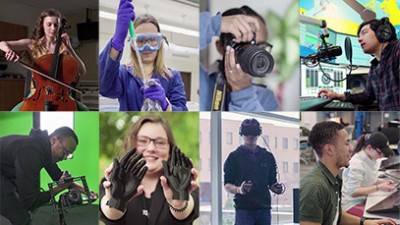Marcia Trauernicht shelves her last book
RIT librarian retires after 38 years
A. Sue Weisler/RIT
RIT Libraries took over the Ritter Ice Arena from 2021 to 2023 during the SHED construction and Wallace library renovation. Marcia Trauernicht and the library staff dubbed their temporary home Wallace on Ice.
Marcia Trauernicht will retire in July after 38 years as an RIT librarian and, most recently, as director of RIT Libraries.
Serendipity and a tip from her husband in 1986 about a temporary job at RIT’s Wallace Library led Trauernicht to apply for her first professional library position. She had just graduated with her master’s degree in library science from the University of Illinois, Champagne-Urbana, and her new husband, Dave Trauernicht, had already moved to Rochester to work at Eastman Kodak Co. He saw the job ad in the classified section of the newspaper and told his wife in Illinois. She wasted no time and sent her resume to RIT.
Years later, Trauernicht learned that her out-of-state application to the locally placed ad puzzled the library hiring committee. On top of that, she discovered she had been the only applicant. Trauernicht seemingly came out of nowhere.
Elizabeth Lamark/RIT
Marcia Trauernicht presents at the first RIT and University of Rochester Library Staff conference held at Wallace Library in June 2016.
In 2017, Trauernicht became director of RIT Libraries. She was honored in 2018 when the university library won the regional Academic Library of the Year award.
During her nearly 40 years at RIT, Trauernicht’s contributions have led to the establishment of the digital institute repository, the digitization lab, and open access publishing at RIT.
“Pretty much during my entire library career, I’ve been near the beginning of digital technology and libraries,” Trauernicht said.
Today, 90 percent of the library’s materials budget supports electronic resources, while print purchases focus mainly on the art and photography collection. The ease of accessing information on the Internet has changed how patrons interact with library staff, Trauernicht said. During peak hours in the 1980s, students waited in long lines to speak to a reference librarian. Now, students schedule focused consultations with their subject-matter librarians or chat with the librarian on call.
How has the SHED changed the library?
During construction, we had to move a big part of our regular collection to Ritter Arena, and we became ‘Wallace on Ice.’ Last summer, we moved back to Wallace and had to set up and get used to our new space.
Before the renovation, the library had one entrance and exit, and now we have about 10 different openings. It’s a very different situation for us.
Previously there was always a lot of activity on the first floor. We had termed that our ‘noisy floor.’ We had a lot of space for students to study together or hangout. The further up you went, the quieter it got. Since we reopened during the regular school year, it is always busy in here. Ten minutes before the hour, when classes change, there is a sea of students going up and down the stairs, elevators, coming in and out through the SHED, and many people stay in between classes.
What are you most proud of during your career?
Cataloguing. You need to become familiar with a number of rules and guidelines that are national and international standards. There is a lot that goes into creating these records. And if you’re doing an original record, sometimes there is a lot of research in the subject area. It’s really an intellectual and research process with the results existing in our online catalog, which is accessible to anybody.
What are some of your fondest memories of your time at RIT?
Provided
Staff from RIT Libraries received the 2018 Academic Library of the year from the Rochester Regional Library Council.
A good part of it was always working with the staff, my colleagues. When I started, most of the people working in the library were roughly the same age, late 20s-early-30s. A few other people were hired about the same time I was. Through the next few decades, we were all constantly working together, and we really got to know each other well.
Trauernicht, who lives with her husband in West Henrietta, N.Y., plans to ease into retirement without making any immediate plans other than visiting her family in Illinois, keeping up with her RIT book club, and learning to draw. She is also considering adopting a canine companion. “My one neighbor said, ‘You need to get a dog.’ Probably.”















